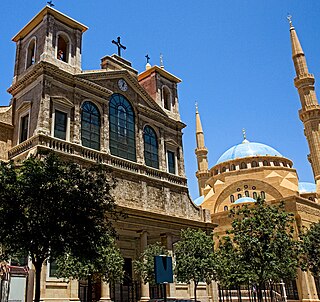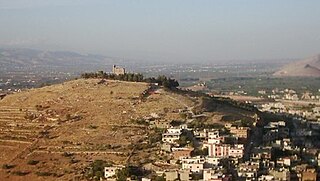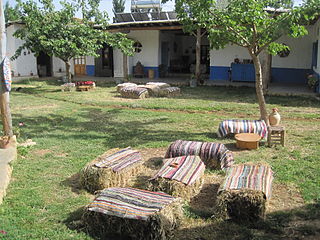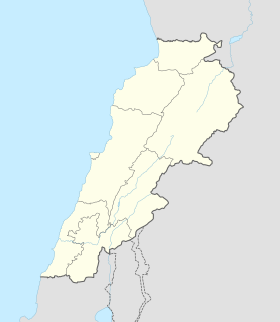
The history of Lebanon covers the history of the modern Republic of Lebanon and the earlier emergence of Greater Lebanon under the French Mandate for Syria and the Lebanon, as well as the previous history of the region, covered by the modern state.
Transportation in Lebanon varies greatly in quality from the ultramodern Beirut International Airport to poor road conditions in many parts of the country. The Lebanese civil war between 1975 and 1990 and the 2006 Lebanon War with Israel severely damaged the country's infrastructure.

The Lebanese Civil War was a multifaceted armed conflict that took place from 1975 to 1990. It resulted in an estimated 150,000 fatalities and led to the exodus of almost one million people from Lebanon.

The Amal Movement is a Lebanese political party and former militia affiliated mainly with the Shia community of Lebanon. It was founded by Musa al-Sadr and Hussein el-Husseini in 1974 as the "Movement of the Deprived." The party has been led by Nabih Berri since 1980. The Greek Catholic Archbishop of Beirut, Grégoire Haddad, as well as Mostafa Chamran, were among the founders of the movement.

The Lebanese Forces is a Lebanese Christian-based political party and former militia during the Lebanese Civil War. It currently holds 19 of the 128 seats in Lebanon's parliament, being the largest party of the country.

The Beqaa Valley is a fertile valley in eastern Lebanon and its most important farming region. Industry, especially the country's agricultural industry, also flourishes in Beqaa. The region broadly corresponds to the Coele-Syria of classical antiquity.

Al-Rafid is a village in the Rashaya District, in the southeastern area of the Beqaa Governorate in Lebanon. Its population is estimated to be 3,000. Its inhabitants are predominantly Sunni Muslims. The village has two mosques, two schools, two pharmacies, and a telecommunications facility.

Armenians have lived in Lebanon for centuries. According to Minority Rights Group International, there are 156,000 Armenians in Lebanon, around 4% of the population. Prior to the Lebanese Civil War, the number was higher, but the community lost a portion of its population to emigration.

The military occupation of Lebanon by Syria lasted from 1976, beginning with the Syrian intervention in the Lebanese Civil War, until April 30, 2005. This period saw significant Syrian military and political influence over Lebanon, impacting its governance, economy, and society. The occupation ended following intense international pressure and the assassination of former Lebanese Prime Minister Rafic Hariri. The legacy of the occupation continues to influence Lebanese-Syrian relations and Lebanon's internal political dynamics.
Hezbollah originated within the Shiite block of Lebanese society. According to the CIA World Factbook estimate in 2022, Shiites comprise 31.2 percent of Lebanon's population, predominating in three areas of Lebanon: Southern Lebanon, Beirut and its environs (Dahieh), and the northern Beqaa valley region.
Sawiri or Sawairy or es-Sawairi (الصويري) is a town in the eastern part of Lebanon.

Lebanon is an eastern Mediterranean country that has the most religiously diverse society within the Middle East, recognizing 18 religious sects. The recognized religions are Islam, Christianity and Judaism.
The Lebanese Forces – Executive Command or LFEC, was a splinter group from the Lebanese Forces led by Elie Hobeika, based at the town of Zahlé in the Beqaa valley during the late 1980s. It was initially founded in January 1986 under the title Lebanese Forces – Uprising or LFU, but later changed its designation.

Qabb Ilyas also spelled Kab Elias, Qab Elias, Qob Elias, Qoub Elias) is a municipality in Zahle District, in eastern Lebanon. Qabb Ilyas is 15 kilometers from Zahleh and 45 kilometers from the Lebanese capital Beirut. Its average elevation above sea level is 950 meters. Its area is approximately 32 km². Qabb Ilyas is the third largest city in the Beqaa Valley, after Zahleh and Baalbek in terms of area size. The majority of the residents are Sunni Muslims.

Majdal Anjar is a village of Beqaa Governorate, Lebanon. Majdal Anjar is an overwhelmingly Sunni Muslim town.

Bachir Pierre Gemayel was a Lebanese militia commander who led the Lebanese Forces, the military wing of the Kataeb Party, in the Lebanese Civil War and was elected President of Lebanon in 1982.

Zahlé is a city in eastern Lebanon, and the capital and largest city of Beqaa Governorate, Lebanon. With around 150,000 inhabitants, it is the third-largest city in Lebanon after Beirut and Tripoli and the fourth-largest taking the whole urban area.

The Lebanese Arab Army – LAA (Arabic: جيش لبنان العربي transliteration Jayish Lubnan al-Arabi), also known variously as the Arab Army of Lebanon (AAL) and Arab Lebanese Army or Armée arabe du Liban (AAL) in French, was a predominantly Muslim splinter faction of the Lebanese Army that came to play a key role in the 1975–77 phase of the Lebanese Civil War.
The War of Brothers was a period of violent armed clashes between rivals Amal and Hezbollah, Lebanon's main Shiite militia movements, during the final stages of the Lebanese Civil War. The fighting broke out in April 1988 and proceeded intermittently in three phases over the following years until the signing of an agreement brokered by their respective foreign backers, Syria and Iran, in November 1990.

Taanayel, also transliterated Tanayal, is a village located in the Zahlé District of the Beqaa Governorate in Lebanon.
















